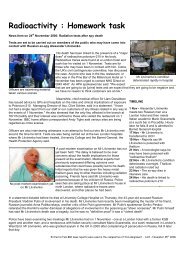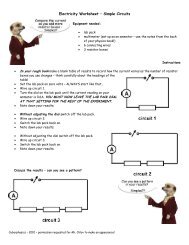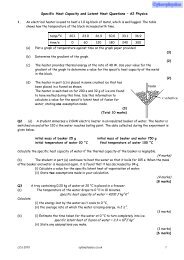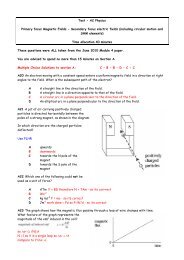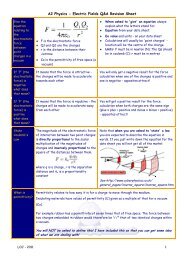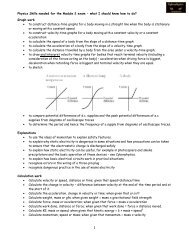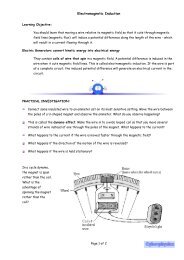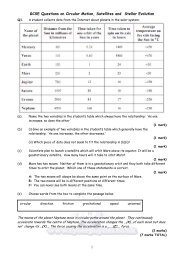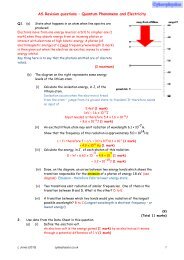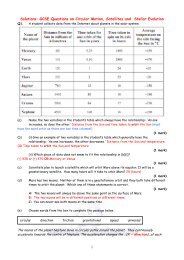Solutions to Questions on Electric Fields - Handout 1 ... - Cyberphysics
Solutions to Questions on Electric Fields - Handout 1 ... - Cyberphysics
Solutions to Questions on Electric Fields - Handout 1 ... - Cyberphysics
You also want an ePaper? Increase the reach of your titles
YUMPU automatically turns print PDFs into web optimized ePapers that Google loves.
<str<strong>on</strong>g>Soluti<strong>on</strong>s</str<strong>on</strong>g> <str<strong>on</strong>g>to</str<strong>on</strong>g> <str<strong>on</strong>g>Questi<strong>on</strong>s</str<strong>on</strong>g> <strong>on</strong> <strong>Electric</strong> <strong>Fields</strong> - <strong>Handout</strong> 1<br />
Q1. Charge Q acts as a point charge <str<strong>on</strong>g>to</str<strong>on</strong>g> create an electric field. Its strength, measured a distance<br />
of 30 cm away, is 40 N/C. Determine the magnitude of the electric field strength at the following<br />
distances from chare Q<br />
a) 60 cm 10 N/C<br />
b) 15 cm 160 N/C<br />
c) 90 cm 4.4 N/C<br />
d) 3 cm 4000 N/C<br />
e) 45 cm 18 N/C<br />
Hints <strong>on</strong> how <str<strong>on</strong>g>to</str<strong>on</strong>g> 'reas<strong>on</strong> out' the answer:<br />
The electric field strength is inversely related <str<strong>on</strong>g>to</str<strong>on</strong>g> the square of the distance. So by whatever fac<str<strong>on</strong>g>to</str<strong>on</strong>g>r d<br />
changes by, the E value is altered in the inverse directi<strong>on</strong> by the square of that fac<str<strong>on</strong>g>to</str<strong>on</strong>g>r.<br />
The specifics are as follows:<br />
a) d increases by a fac<str<strong>on</strong>g>to</str<strong>on</strong>g>r of 2; divide the original E by 4.<br />
b) d decreases by a fac<str<strong>on</strong>g>to</str<strong>on</strong>g>r of 2; multiply the original E by 4.<br />
c) d increases by a fac<str<strong>on</strong>g>to</str<strong>on</strong>g>r of 3; divide the original E by 9.<br />
d) d decreases by a fac<str<strong>on</strong>g>to</str<strong>on</strong>g>r of 10; multiply the original E by 100.<br />
e) d increases by a fac<str<strong>on</strong>g>to</str<strong>on</strong>g>r of 1.5; divide the original E by (1.5) 2 .<br />
Q2. Charge Q acts as a point charge <str<strong>on</strong>g>to</str<strong>on</strong>g> create an electric field. Its strength, measured a distance<br />
of 30 cm away, is 40 N/C. What would be the electric field strength:<br />
a) 30 cm away from a source with charge 2Q? 80 N/C<br />
b) 30 cm away from a source with charge 3Q? 120 N/C<br />
c) 60 cm away from a source with charge 2Q? 20 N/C<br />
d) 15 cm away from a source with charge 2Q? 320 N/C<br />
e) 150 cm away from a source with charge 0.5Q? 0.80 N/C<br />
Hints <strong>on</strong> how <str<strong>on</strong>g>to</str<strong>on</strong>g> 'reas<strong>on</strong> out' the answer:<br />
The E value is directly related <str<strong>on</strong>g>to</str<strong>on</strong>g> the source charge and inversely related <str<strong>on</strong>g>to</str<strong>on</strong>g> the square of the<br />
distance. Alter E by the same fac<str<strong>on</strong>g>to</str<strong>on</strong>g>r that the charge changes by; and alter E by the inverse square of<br />
the fac<str<strong>on</strong>g>to</str<strong>on</strong>g>r that d is changed by.<br />
The specifics are as follows<br />
a) Twice the source charge will double the E value.<br />
b) Three times the source charge will triple the E value.<br />
c) Two changes are required: double E since the source charge doubled and divide by 4<br />
since the distance increased by a fac<str<strong>on</strong>g>to</str<strong>on</strong>g>r of 2.<br />
d) Two changes are required: double E since the source charge doubled and multiply by 4<br />
since the distance decreased by a fac<str<strong>on</strong>g>to</str<strong>on</strong>g>r of 2.<br />
e) Two changes are required: divide E by 2 since the source charge halved and divide by<br />
25 since the distance increased by a fac<str<strong>on</strong>g>to</str<strong>on</strong>g>r of 5.<br />
These questi<strong>on</strong>s were adapted from questi<strong>on</strong>s <strong>on</strong> the site www.physicsclassroom.com (2011)
Q3. Copy and complete the following table.<br />
<str<strong>on</strong>g>Soluti<strong>on</strong>s</str<strong>on</strong>g> <str<strong>on</strong>g>to</str<strong>on</strong>g> <str<strong>on</strong>g>Questi<strong>on</strong>s</str<strong>on</strong>g> <strong>on</strong> <strong>Electric</strong> <strong>Fields</strong> - <strong>Handout</strong> 1<br />
General points:<br />
1) the E value will always be equal <str<strong>on</strong>g>to</str<strong>on</strong>g> the F / q ratio.<br />
2) Any alterati<strong>on</strong> in q (without altering Q and d) will not effect the E value.<br />
3) If q is altered by some fac<str<strong>on</strong>g>to</str<strong>on</strong>g>r, F is altered by that same fac<str<strong>on</strong>g>to</str<strong>on</strong>g>r; but if Q and d are not<br />
changed, the E will not be changed.<br />
4) In the last two rows, the values in red can be any number provided that the F/q ratio is equal<br />
<str<strong>on</strong>g>to</str<strong>on</strong>g> the E value.<br />
Specific points are as follows:<br />
a) Find E by calculating F / q (both of which are given).<br />
b) Find F by multiplying E by q (both of which are given).<br />
c) Find E by calculating F/q (both of which are given).<br />
d) Find F by multiplying E by q (both of which are given).<br />
e) First find E, reas<strong>on</strong>ing that since Q and d are the same in this row as the previous row, the E<br />
value must also be the same. Then find q by multiplying the given value of F by your calculated<br />
value for E.<br />
f) Find F by multiplying E by q (both of which are given).<br />
g) First find E, reas<strong>on</strong>ing that since Q and d are the same in this row as the previous row, the E<br />
value must also be the same. Then find F by multiplying the calculated value of E by the given<br />
value of q.<br />
h) First find E, reas<strong>on</strong>ing that since Q and d are the same in this row as the previous row, the E<br />
value must also be the same. Then find q by multiplying the given value of F by your calculated<br />
value for E.<br />
i) Any value of q and F can be selected provided that the F/q ratio is equal <str<strong>on</strong>g>to</str<strong>on</strong>g> the given value of<br />
E.<br />
j) First find E, reas<strong>on</strong>ing that since Q and d are the same in this row as the previous row, the E<br />
value must also be the same. Then any value of q and F can be selected provided that the F/q<br />
ratio is equal <str<strong>on</strong>g>to</str<strong>on</strong>g> the determined value of E.<br />
These questi<strong>on</strong>s were adapted from questi<strong>on</strong>s <strong>on</strong> the site www.physicsclassroom.com (2011)
<str<strong>on</strong>g>Soluti<strong>on</strong>s</str<strong>on</strong>g> <str<strong>on</strong>g>to</str<strong>on</strong>g> <str<strong>on</strong>g>Questi<strong>on</strong>s</str<strong>on</strong>g> <strong>on</strong> <strong>Electric</strong> <strong>Fields</strong> - <strong>Handout</strong> 1<br />
Q4. In the table above, identify at least two rows that illustrate that the strength of the electric<br />
field vec<str<strong>on</strong>g>to</str<strong>on</strong>g>r is ...<br />
a) directly related <str<strong>on</strong>g>to</str<strong>on</strong>g> the quantity of charge <strong>on</strong> the source charge (Q).<br />
b) inversely related <str<strong>on</strong>g>to</str<strong>on</strong>g> the square of the separati<strong>on</strong> distance (d).<br />
c) independent of the quantity of charge <strong>on</strong> the test charge (q).<br />
a) Rows a and c or rows b and d. To illustrate that E is directly related <str<strong>on</strong>g>to</str<strong>on</strong>g> Q, you must find a set<br />
of rows in which Q is altered by some fac<str<strong>on</strong>g>to</str<strong>on</strong>g>r while q and d are c<strong>on</strong>stant.<br />
b) Rows d and f or rows c and h. To illustrate that E is inversely related <str<strong>on</strong>g>to</str<strong>on</strong>g> d 2 , you must find a<br />
set of rows in which d is altered by some fac<str<strong>on</strong>g>to</str<strong>on</strong>g>r while q and Q are kept c<strong>on</strong>stant.<br />
c) Rows a and b or rows d and e or rows f and g. To illustrate that E is independent of q you<br />
must find a set of rows in which q is altered but Q and d are kept c<strong>on</strong>stant.<br />
Q5. Use unit analysis <str<strong>on</strong>g>to</str<strong>on</strong>g> identify whether kg ms -2 C -1 is an acceptable unit for electric field<br />
strength.<br />
Answer: Yes it is.<br />
A kg is a unit of mass and a m/s 2 is a unit of accelerati<strong>on</strong>. So a kg m/s 2 is a unit of force; in fact, it is<br />
equivalent <str<strong>on</strong>g>to</str<strong>on</strong>g> a new<str<strong>on</strong>g>to</str<strong>on</strong>g>n. Replacing the kg m/s 2 with N c<strong>on</strong>verts this set of units <str<strong>on</strong>g>to</str<strong>on</strong>g> N/C which is the<br />
standard metric unit of electric field as E=F/Q.<br />
Q6. Ballo<strong>on</strong> A is negatively charged. It is observed that ballo<strong>on</strong> B exerts a repulsive force up<strong>on</strong><br />
ballo<strong>on</strong> A. Would the electric field vec<str<strong>on</strong>g>to</str<strong>on</strong>g>r created by ballo<strong>on</strong> B be directed <str<strong>on</strong>g>to</str<strong>on</strong>g>wards B or away from B?<br />
Explain your reas<strong>on</strong>ing.<br />
Answer: Towards B<br />
If ballo<strong>on</strong> B repels ballo<strong>on</strong> A then ballo<strong>on</strong> B must be negatively charged. The electric field vec<str<strong>on</strong>g>to</str<strong>on</strong>g>rs<br />
are always directed <str<strong>on</strong>g>to</str<strong>on</strong>g>wards negatively charged objects. As such, the E vec<str<strong>on</strong>g>to</str<strong>on</strong>g>rs must be <str<strong>on</strong>g>to</str<strong>on</strong>g>wards<br />
ballo<strong>on</strong> B.<br />
These questi<strong>on</strong>s were adapted from questi<strong>on</strong>s <strong>on</strong> the site www.physicsclassroom.com (2011)



